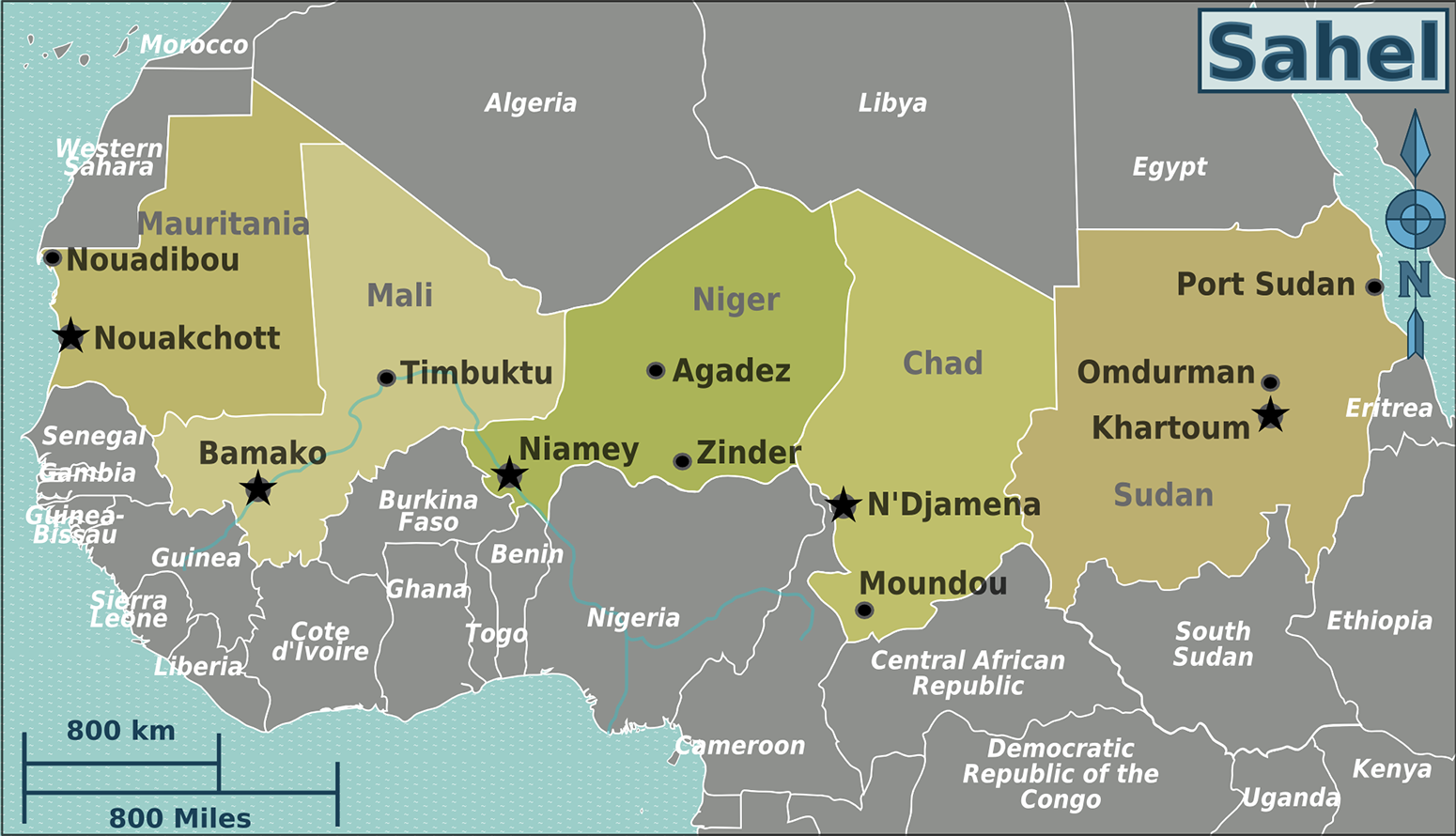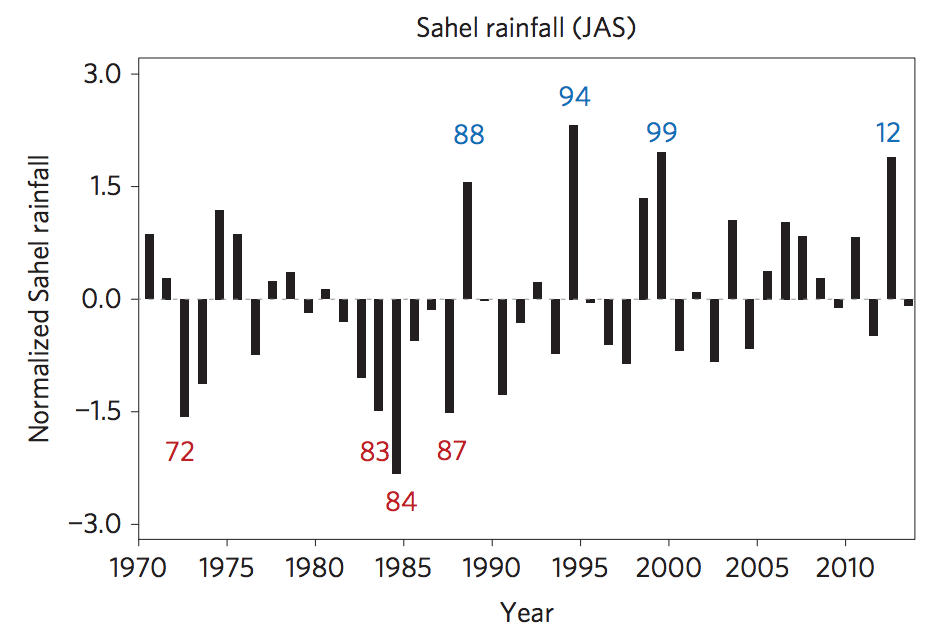Robert McSweeney
27.06.2016 | 4:11pmFollowing a severe drought in the 1970s and 80s, the Sahel region of Africa has seen something of a recovery in its rainfall.
A new study, just published in Nature Climate Change, suggests this recovery has been prompted by rising temperatures in the Mediterranean Sea.
Looking ahead, the study suggests continued warming could make reliable rainfall more likely in the future. But climate change won’t be beneficial for the Sahel – or Africa – overall, another scientist tells Carbon Brief.
Decline and rise
The Sahel region stretches from the Atlantic coast of Mauritania and Senegal through to Sudan, Eritrea and the Red Sea. It gets almost all of its rainfall in one wet season between June and September. The rain is delivered by the Intertropical Convergence Zone (ITCZ), a huge belt of low pressure that encircles the Earth near the equator.

Map of the Sahel region in Saharan Africa. Credit: Peter Fitzgerald/LtPowers/Wikimedia Commons.
The ITCZ wanders north and south across the tropics each year, roughly tracking the position of the sun through the seasons. The Sahel marks the ITCZ’s most northerly position.
However, the movements of the ITCZ can be erratic, with striking consequences.
Between the 1960s and 80s, the ITCZ gradually shifted southwards, depriving the Sahel of its annual deluge and causing widespread drought and famine. Rainfall totals have since shown a partial recovery.
You can see this decline and recovery in the chart below. The bars indicate rainfall totals for each year’s wet season, as a proportion of the long-term average. Bars with negative totals are dry years, while those with positive totals are wet years. Notable years are indicated with red (dry years) or blue (wet years) text.

Summer (June to September) rainfall totals in the Sahel, from 1970 to 2013, as a proportion of the long-term average. Labels show particularly wet (blue text) and dry (red text) years. Source: Park et al. (2016).
Scientists have attributed the ITCZ’s southerly shift and the subsequent drought to natural temperature fluctuations in the Atlantic, Pacific and Indian Oceans. However, the new study finds that these fluctuations are not responsible for the recovery.
Simulating Sahel rainfall in a climate model, the researchers find that the principal cause is human-caused warming of the Mediterranean Sea.
Moisture supply
So, how does a warmer Costa del Sol trigger rainfall over several thousand kilometres away in Africa?
A warmer Mediterranean means more moisture from the sea is evaporated into the air, the study says. This moisture is then carried over to the Sahel by summer winds that blow south towards North Africa.
Lead author Dr Jong-yeon Park, a researcher at the Max Planck Institute for Meteorology in Hamburg, explains to Carbon Brief what effect this has:
In contrast, when the researchers ran their model without the Mediterranean warming, it simulated a continued drying of the Sahel.
The study shows how the Mediterranean Sea has emerged to be the dominant factor for Sahel rainfall, says Prof Michela Biasutti, an expert in tropical climate change at Columbia University, in an accompanying News & Views article:
‘Favourable condition’
Having identified the likely cause of the Sahel recovery, the researchers turned to what might happen in future.
Using a second model, they find the influence of the Mediterranean Sea is likely to become increasingly important for Sahel rainfall as the climate continues to warm.
You can see this in the chart below, which shows the projected change in Sahel rainfall as sea surface temperatures in the Mediterranean Sea (blue dots), North Atlantic (brown pluses), North Pacific (red triangles) and Arctic Ocean (green crosses) rise.

Projected impact of future sea surface temperature rise on Sahel rainfall, for the Mediterranean Sea (blue dots), North Atlantic (brown pluses), North Pacific (red triangles) and Arctic Ocean (green crosses). Source: Park et al. (2016).
The results suggest that continued warming in the Mediterranean will see the recovery in Sahel rainfall continue, says Park:
But this isn’t to say that continued climate change will be beneficial overall for the Sahel, Biasutti tells Carbon Brief:
Rising temperatures will be an additional concern for the Sahel, she adds:
It’s also not certain that Sahel rainfall would decrease again if warming in the Mediterranean was halted or reversed, says Park:
Uncertainties
The new research comes to a different conclusion from a study published last year, which suggested the Sahel rainfall recovery was a result of the direct warming effect of rising CO2 levels.
Because land heats up faster than water, the African continent has warmed more quickly than the surrounding ocean. This shifted the ITCZ northwards and brought more persistent rain to the Sahel, the earlier study says.
However, Park says that the model used in that study underestimated the impact of warming sea surface temperatures and the amount of moisture they add to the atmosphere:
The new study suggests a “new dimension” for a complete understanding of Sahel rainfall variability and change, says Dr Buwen Dong, senior research scientist at the University of Reading and lead author of the earlier study.
But as the study is only based on two climate models, it needs to be tested with others before drawing concrete conclusions about the future of Sahel rainfall, he tells Carbon Brief:
Main image: Driving into an August storm in Tapoa Province, Burkina Faso. Credit: Eric Haglund/Flickr.
Park, J. et al. (2016) Anthropogenic Mediterranean warming essential driver for present and future Sahel rainfall, Nature Climate Change, doi:10.1038/nclimate3065 & Biasutti, M. (2016) What brings rain to the Sahel?, Nature Climate Change.

